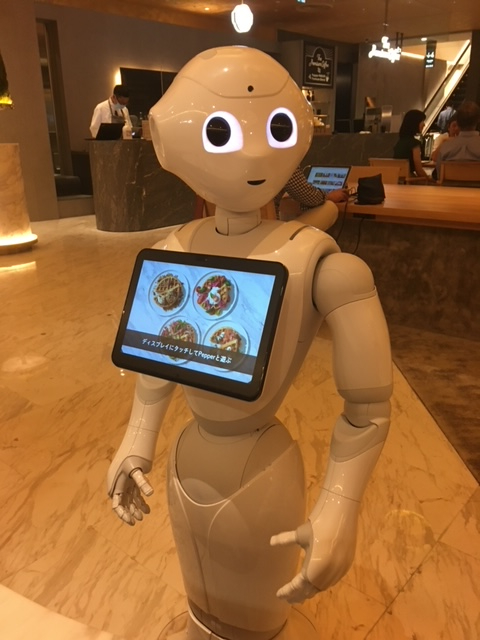
letters-home-japanese-server-robots-in-restaurants
Recently, when friends from overseas were visiting me here in Japan, we went out to dinner near my home and they were fascinated with the robots that deliver the food to the table.
Honestly, I barely notice them anymore because they have become rather common in many different types of eating establishments around Japan. However, nearly everyone from home who visits here are intrigued and excited about the proliferation of robotic waiters in restaurants which are rapidly becoming standard in Japan.
I think the U.S. has been slower in adopting these robotic servers, but they will eventually spread in the U.S. just as they are currently doing here.
My first experience with “robotic staff” was several years ago at the Pepper Café in Shibuya, in Tokyo. Upon entering the shop, customers place their orders with a humanoid-like robot at a counter, and then, after being seated, a robot delivers the food items to the table. The Pepper Café robots have a humanoid appearance, but glide effortlessly on wheels. They aren’t very interactive apart from the initial ordering. They do have screens that can be interactive with the diners allowing diners to watch a programmed video.
The most common robots in restaurants are boxier in shape, and some have a screen that features a cartoon-like cat face that would be where the head on a human would normally be. The design of these is basically a shelving unit with trays that allow food items to be placed on several different shelves on the robot, and once it stops at the table, the diner just reaches over to take the food items off one of the shelves.
Earlier this year, I read a newspaper article that featured “cooking robots,” which are designed to do perfunctory tasks in the kitchen in order to free up the human staff to attend to the needs of customers more readily by supposedly adding a higher level of customer service. I personally have my doubts.
I suspect the ultimate goal is to get rid of human workers all together in order for robots to do all of the work from greeting, seating, taking orders, cooking, delivery of the food, and clearing the tables. The company that developed the “cooking robots” program them to follow specific recipes, and the robots are able to change recipes according to individual requests like custom seasoning (less salt or to omit an ingredient that the diner may be allergic to or not want to eat).
I don’t think the cooking robots are standard yet, by any means, but the serving robots certainly are and more and more restaurants are adopting them, even in my small town here in Japan. The COVID-19 pandemic precipitated the push to adopt robots more widely when restaurants were trying to lure customers back into their eating establishments after such a long hiatus due to the restrictions imposed to combat the spread of the Coronavirus.
“Contactless service” became the preferred way of doing all sorts of interactions.
The 7-11 near my condo instituted a system where the cashier still rings up the items but does not touch the money at all. A machine is used for the payment, as to avoid any direct, hand-to-hand contact with money. While it is partly due to the desire to limit human-to-human contact between the staff and customers, it’s also because there was a huge labor shortage, and once the pandemic started to wane, restaurants needed to be able to serve customers so the robots filled this staffing void quite nicely.
The robots really are fascinating to watch in action, as they speed down the aisles between tables, and if they sense something in their way, they stop immediately. I did notice a near collision when a staff person was rounding a corner and a robot was coming in the opposite direction. The robot realized a person was there before the human staff person reacted to the robot.
When the robot arrives to the table, it will apologize if the food took too long to be delivered, or it will say something like “Thank you for waiting.”
Is it as nice as having an interaction with an actual human? Not really, but it is a novelty and for people who aren’t familiar with having food served by a robot regularly, it can be fun and amusing.
Will robots replace humans completely in restaurants? Eventually, probably, but that is a ways off, I think. These robots still are not able to do the bulk of what human staff do to keep a restaurant going, but bit by bit, I suspect more advanced units will be introduced and much of the work will eventually replace human staff.
Just look at checkouts in places like Walmart today. Getting a live cashier to check out is becoming more and more rare … the same is true in Japan. The trend in Japan, though, is to have the cashiers ring up the purchases and the customer is directed to a machine to pay the bill.
It has always been the custom in Japan that the customer bags the groceries himself/herself.Just lately I have experienced the complete self-checkout system here in Japan. A 100-yen shop near where I live has done away with all cashiers and each customer now rings up the purchase without any cashier present. A staff person stands to the side in case someone needs assistance.
I can’t say I dislike the robot system of serving food, but I can’t say I love it, either. It is what it is, I guess. I like having human interaction with the serving staff. That is the American in me … we like idle chit-chat with strangers anytime and anywhere!
I am sure Japanese people are quite happy not to have to engage in mindless banter with people. We Americans thrive on “shooting the breeze” with strangers we meet while waiting in a line, or while ordering food at a restaurant.
Get the most recent Shelby County Post headlines delivered to your email. Go to shelbycountypost.com and click on the free daily email signup link at the top of the page.





